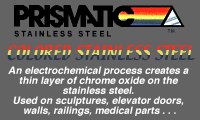
-----
Anodizing Stainless Steel?
1998
I was wondering if it was possible to anodize Stainless Steel? If it is possible I was wondering if you could tell me how to do it. Is it the same process as aluminum?
Thanks
David StevensDave:
Anodic treatment of stainless steel is known as electropolishing. The process is similar to, but differs in details from, aluminum anodizing. In anodizing, the surface oxide builds up and eventually stops the flow of current. In electropolishing, the oxide layer is continuously removed as it forms. The final thickness typically ends up in the range of 30-50 angstroms.
adv.
For further information, please look up our web site via the link below.
Metal Coating Process Corporation - Charlotte, North Carolina
1998
December 6, 2012
Hi David. Although Ed is certainly correct that electropolishing of stainless steel is an anodic treatment for stainless steel, it is not the only anodic treatment for stainless steel.
There is an 'anodizing' process for stainless steel which is much more like the anodizing of titanium than the anodizing of aluminum.
In color anodizing of aluminum, the anodized layer is rather thick and it is honeycomb-like, although on a much smaller scale. After anodizing, the parts are immersed in dye, which is absorbed into the honeycomb; then the parts are exposed to boiling water, steam, or other agents which swell the honeycomb walls, closing them off. So the color you see is the dye.
In the color anodizing of titanium and stainless steel, no dye is involved. Rather, a very thin almost transparent layer of oxide is created on the surface, and the layer is of the proper thickness to create an interference pattern like the coloration of carnival glass or the rainbow coloration of an oil slick on a puddle. If you take a CD or DVD and turn it at various angles to your eyes you will see a rainbow as you are looking through different depths of clear plastic depending on the angle you hold it at.
However, I don't think the techniques for anodizing of stainless steel are generic knowledge yet. You may have to license the technology or purchase the service unless you intend to spend significant research efforts.
Regards,

Ted Mooney, P.E.
Striving to live Aloha
finishing.com - Pine Beach, New Jersey
Ted can be retained for immediate
answers or long term project help
Q, A, or Comment on THIS thread -or- Start a NEW Thread
